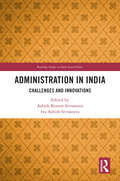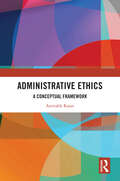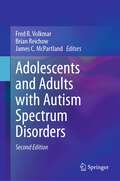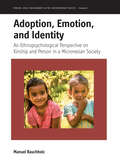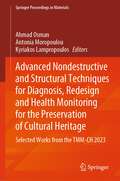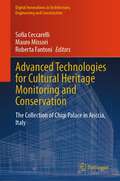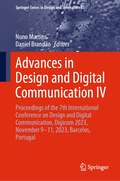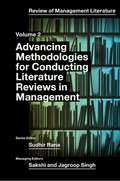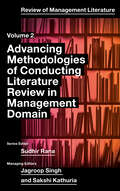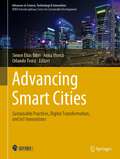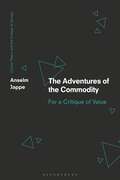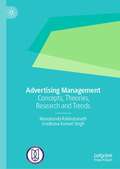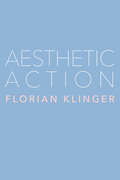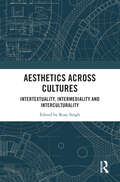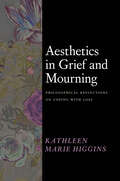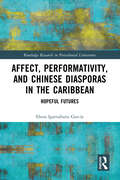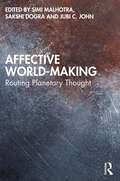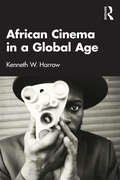- Table View
- List View
Administration in India: Challenges and Innovations (Routledge Studies in South Asian Politics)
This book offers a comprehensive analysis of the administration in India from independence to date. It examines the major transformation in the administrative service initiated by the ‘Minimum Government and Maximum Governance’ initiative of the Government of India in 2014. In spite of enormous diversity and population, India has made remarkable progress in various fields such as health, education, infrastructure, and technology. Structured in three parts, (1) social sector, (2) infrastructure and economy, and (3) e-governance and service delivery, the book examines challenges of governance and provides insight into different innovations undertaken to address these challenges. E-governance lies at the core of this transformation of accountability, transparency, and time-bound service delivery. Contributions in this book are written by experts working in the Indian Administrative Service (IAS), academia, and the private sector and cover a wide spectrum of administration from the point of view of different departments of government, as well as the experiences of the authors ranging from senior bureaucrats to mid-career officers and analyses of researchers on administration and its challenges. The initiatives covered in this book can serve as solutions to similar challenges faced by other developing countries in the world. The book will be of interest to researchers in the fields of administration and policy, civil service, public management, South Asian politics, and Development Studies.
Administration in India: Challenges and Innovations (Routledge Studies in South Asian Politics)
by Ashish Kumar Srivastava Iva Ashish SrivastavaThis book offers a comprehensive analysis of the administration in India from independence to date. It examines the major transformation in the administrative service initiated by the ‘Minimum Government and Maximum Governance’ initiative of the Government of India in 2014. In spite of enormous diversity and population, India has made remarkable progress in various fields such as health, education, infrastructure, and technology. Structured in three parts, (1) social sector, (2) infrastructure and economy, and (3) e-governance and service delivery, the book examines challenges of governance and provides insight into different innovations undertaken to address these challenges. E-governance lies at the core of this transformation of accountability, transparency, and time-bound service delivery. Contributions in this book are written by experts working in the Indian Administrative Service (IAS), academia, and the private sector and cover a wide spectrum of administration from the point of view of different departments of government, as well as the experiences of the authors ranging from senior bureaucrats to mid-career officers and analyses of researchers on administration and its challenges. The initiatives covered in this book can serve as solutions to similar challenges faced by other developing countries in the world. The book will be of interest to researchers in the fields of administration and policy, civil service, public management, South Asian politics, and Development Studies.
Administrative Ethics: A Conceptual Framework
by Amitabh RajanThis insightful book explores the use and application of ethics in contemporary governance and suggests necessary reforms. Following an interdisciplinary approach involving the fields of political science, law, economics, sociology, management, and philosophy, this book analyses their applicability and usefulness in everyday practices in governance, covering its five cardinal virtues—prudence, transparency, discourse, justice, and accountability. Highlighting ethical challenges in aspects of status recognition, oppression, empowerment, social care, public financing, environment protection and others in today’s interconnected world, it delves into the dynamics of administrative power in democracies and showcases how the misuse of power can be controlled through a discourse of ethics in law and governance. The book will be useful to the students, researchers and teachers of public administration, philosophy, political Science, corporate ethics, and governance other related social sciences disciplines. The book will also be an indispensable companion to social activists, advocacy groups, journalists and civil society institutions and public service training institutions.
Administrative Ethics: A Conceptual Framework
by Amitabh RajanThis insightful book explores the use and application of ethics in contemporary governance and suggests necessary reforms. Following an interdisciplinary approach involving the fields of political science, law, economics, sociology, management, and philosophy, this book analyses their applicability and usefulness in everyday practices in governance, covering its five cardinal virtues—prudence, transparency, discourse, justice, and accountability. Highlighting ethical challenges in aspects of status recognition, oppression, empowerment, social care, public financing, environment protection and others in today’s interconnected world, it delves into the dynamics of administrative power in democracies and showcases how the misuse of power can be controlled through a discourse of ethics in law and governance. The book will be useful to the students, researchers and teachers of public administration, philosophy, political Science, corporate ethics, and governance other related social sciences disciplines. The book will also be an indispensable companion to social activists, advocacy groups, journalists and civil society institutions and public service training institutions.
Adolescents and Adults with Autism Spectrum Disorders
by Fred R. Volkmar Brian Reichow James C. McPartlandThe second edition of this book examines the numerous research and practice advances with regard to adolescents and adults with autism spectrum disorders (ASD). Expert contributors offer cogent reviews of complex issues, from education to employment, leisure activities to illegal behaviors, mental health issues to medical health concerns. The volume explores the latest findings in key areas, such as psychosocial and residential treatments, social skills programs, epidemiology, the impact of ASD on families. The book focuses on areas of research and practice that require improved models of assessment, current data, new interventions, and increased support services. Key areas of coverage include: Transition from high school to adulthood for adolescents and young adults with ASD. Innovative programming to support college students with ASD. Romantic relationships, sexuality and ASD. Treatment of mental health comorbidities. Assessment and treatment planning in adults with ASD. The range of outcomes and challenges in middle and later life for individuals with autism. The second edition of Adolescents and Adults with Autism Spectrum Disorders is a must-have reference for researchers, professors, and graduate students as well as clinicians, therapists, and other practitioners in clinical child, school, and developmental psychology, psychiatry, social work, rehabilitation medicine/therapy, special education, and general practice/family medicine.
Adoption, Emotion, and Identity: An Ethnopsychological Perspective on Kinship and Person in a Micronesian Society (Person, Space and Memory in the Contemporary Pacific #8)
by Manuel RauchholzExploring adoption in the Pacific, this book goes beyond the commonplace structural-functional analysis of adoption as a positive “transaction in parenthood.” It examines the effects it has on adoptees’ inner sense of self, their conflicted emotional lives, and familial relationships that are affected by a personal sense of rejection and not belonging. This account is theoretically rooted in ethnopsychology, based on field work conducted across multiple research sites in the Chuuk Lagoon, its neighboring Chuukic-speaking atolls, and persons from neighboring Micronesian island communities.
Advanced Nondestructive and Structural Techniques for Diagnosis, Redesign and Health Monitoring for the Preservation of Cultural Heritage: Selected Works from the TMM-CH 2023 (Springer Proceedings in Materials #33)
by Ahmad Osman Antonia Moropoulou Kyriakos LampropoulosThis book comprises the proceedings of the third TMM_CH International Conference on "Transdisciplinary Multispectral Modelling and Cooperation for the Preservation of Cultural Heritage." This book showcases the latest advancements in non-destructive testing and structural techniques across a wide range of applications within the realm of cultural heritage. The conference, held at the esteemed Eugenides Foundation in Athens, Greece, brought together scientists, engineers, architects, archeologists, conservators, geologists, art historians, and other stakeholders. Thirteen sessions and panel discussions featuring 142 esteemed panelists provided a platform for the exchange of ideas. With a significant online presence and approximately 50,000 online viewers, the conference had a profound impact on a global scale. This book serves as a valuable resource, presenting recent scientific breakthroughs, non-destructive techniques, and technologies that contribute to the holistic preservation of our world's cultural heritage.
Advanced Technologies for Cultural Heritage Monitoring and Conservation: The Collection of Chigi Palace in Ariccia, Italy (Digital Innovations in Architecture, Engineering and Construction)
by Sofia Ceccarelli Mauro Missori Roberta FantoniThis book provides the results of an extensive scientific measurements campaign using advanced technologies and innovative non-invasive approaches carried out for the first time in such large numbers inside one of the most important baroque residences in Italy, the Chigi Palace in Ariccia, near Rome (Italy), with the aims of monitoring, characterizing and documenting several kinds of heritage items with different conservative and artistic issues. The analyses involved several research groups from regional universities (Sapienza, Tor Vergata, Roma 3) and research institutions (ENEA, INFN, CNR) and they were performed within the ADAMO project, which was addressed to technologies of analysis, diagnostics and monitoring for the preservation and restoration of Cultural Heritage. The project was proposed by the Centre of Excellence at the Technological District for Cultural Heritage (DTC) financed by the Lazio Region. At the Chigi Palace, important collections of paintings, documents, statues and wall decorations are preserved, dating back from the 16th up to the 18th centuries. The purpose of this book is twofold: it provides an overview of methodologies and technologies currently available in the field of heritage science, through the presentation of their in situ applications for the study of different artworks and materials; furthermore, it shows how the non-invasive analyses and the integration of diagnostic results are useful and sometimes crucial, for the overall understanding of heritage items, their conservation status, and for their correct conservation. This book is addressed at a large audience with both humanistic and scientific backgrounds, focusing the reader's attention on the information gained from multidisciplinary studies, also allowing a curious look at scientific methodologies applied to an art-historical context.
Advances in Design and Digital Communication IV: Proceedings of the 7th International Conference on Design and Digital Communication, Digicom 2023, November 9–11, 2023, Barcelos, Portugal (Springer Series in Design and Innovation #35)
by Nuno Martins Daniel BrandãoThis book reports on research findings and practical lessons featuring advances in the areas of digital and interaction design, graphic design and branding, design education, society and communication in design practice, and related ones. Gathering the proceedings of the 7th International Conference on Digital Design and Communication, Digicom 2023, held on November 9-11, 2023, as a hybrid event, in/from Barcelos, Portugal, this book continues the tradition of the previous ones reporting on new design strategies to foster digital communication within and between the society, institutions and brands. By highlighting innovative ideas and reporting on multidisciplinary projects, it offers a source of inspiration for designers of all kinds, including graphic and web designers, UI, UX and social media designers, and to researchers, advertisers, artists, and brand and corporate communication managers alike.
Advancing Methodologies of Conducting Literature Review in Management Domain (Review of Management Literature #2)
by Sudhir RanaGiving new insight into the theories behind management literature reviews, Advancing Methodologies of Conducting Literature Review in Management Domain explores a range of novel ideas on how to plan, organize, synthesize, and present the results from previous literature from across management research. Specific areas examined in this volume include planning and setting the objectivity of review papers, search processes, data selection and screening, review types and designs, and evaluation criteria, validity, and reliability.
Advancing Methodologies of Conducting Literature Review in Management Domain (Review of Management Literature #2)
by SUDHIR RANA, JAGROOP SINGH AND SAKSHI KATHURIAGiving new insight into the theories behind management literature reviews, Advancing Methodologies of Conducting Literature Review in Management Domain explores a range of novel ideas on how to plan, organize, synthesize, and present the results from previous literature from across management research. Specific areas examined in this volume include planning and setting the objectivity of review papers, search processes, data selection and screening, review types and designs, and evaluation criteria, validity, and reliability.
Advancing Smart Cities: Second Edition (Advances In Science, Technology And Innovation Ser.)
by Simon Elias Bibri Anna Visvizi Orlando TroisiThe Adventures of the Commodity: For a Critique of Value (Critical Theory and the Critique of Society)
by Anselm JappeThe Adventures of the Commodity explores conceptions of a capitalist society that is ordered entirely around the exigencies of the commodity, money and labour.A distinctive introduction to critiques of capitalism and commodity society, this book illuminates the difficult concept of 'abstract' labour. Merging this with the social critique known as the “critique of value”, first developed by Robert Kurz and the German journal, Krisis, in the 1990s, Anselm Jappe highlights in particular a central, and often contested, aspect of this critique: the claim that, for several decades now, capitalism has entered into a crisis that is not cyclical, but terminal. If a society that is founded upon the fetishism of the commodity, on the value created by the abstract side of labour and represented in money, this is the result of the fact that its primary internal contradiction has reached a point of no return: the replacement of living labour, the only source of 'value', by ever-more sophisticated technologies.
Advertising Management: Concepts, Theories, Research and Trends
by Manukonda Rabindranath Aradhana Kumari SinghThis book explores the concept of advertising and the different ways advertising is understood and evaluated. It dives deep into planning, designing, and executing advertising campaigns on different mediums. It discusses the theoretical and research parts of advertising by critically examining how over the years various hierarchical models and theories are developed by advertising experts.It examines various models and theories that explain why and how advertising is successful in persuading customers/target audiences to buy a product or accept an idea for behavioural change. It will help readers to understand the significance of advertising and consumer psychology which has a critical role in purchasing a product or an idea.
Aesthetic Action
by Florian KlingerIn this new book, Florian Klinger gives readers a basic action-theoretical account of the aesthetic. While normal action fulfills a determinate concept, Klinger argues, aesthetic action performs an indeterminacy by suspending the action's conceptual resolution. Taking as examples work by Tino Sehgal, Kara Walker, Mazen Kerbaj, Marina Abramović, Cy Twombly, and Franz Kafka, the book examines indeterminacy in such instances as a walk that is at once leisurely and purposeful, a sound piece that is at once joyous and mournful and mechanical, or a sculpture that at once draws one in and shuts one out. Because it has irresolution as its point, aesthetic action presents itself as an unsettling of ourselves, our ways, our very sense of who we are. As performers of such action, we don't recognize one another as bearers of a shared human form as we normally would, but find ourselves tasked anew with figuring out what sharing a form would mean. In conversation with philosophers such as Kant, Hegel, Wittgenstein, and Anscombe; political thinkers such as Marx and Lorde; and contemporary interlocutors such as Michael Thompson, Sebastian Rödl, and Thomas Khurana, Klinger's book makes a case for a conception of the human form that systematically includes the aesthetic: an actualization of the form that is indeterminate and nevertheless rational. The book gives the project of Western philosophical aesthetics a long-overdue formulation for our present that aims to do justice to contemporary aesthetic production as it actually exists. It will appeal to those working in philosophy, art, and political thought.
Aesthetic Action
by Florian KlingerIn this new book, Florian Klinger gives readers a basic action-theoretical account of the aesthetic. While normal action fulfills a determinate concept, Klinger argues, aesthetic action performs an indeterminacy by suspending the action's conceptual resolution. Taking as examples work by Tino Sehgal, Kara Walker, Mazen Kerbaj, Marina Abramović, Cy Twombly, and Franz Kafka, the book examines indeterminacy in such instances as a walk that is at once leisurely and purposeful, a sound piece that is at once joyous and mournful and mechanical, or a sculpture that at once draws one in and shuts one out. Because it has irresolution as its point, aesthetic action presents itself as an unsettling of ourselves, our ways, our very sense of who we are. As performers of such action, we don't recognize one another as bearers of a shared human form as we normally would, but find ourselves tasked anew with figuring out what sharing a form would mean. In conversation with philosophers such as Kant, Hegel, Wittgenstein, and Anscombe; political thinkers such as Marx and Lorde; and contemporary interlocutors such as Michael Thompson, Sebastian Rödl, and Thomas Khurana, Klinger's book makes a case for a conception of the human form that systematically includes the aesthetic: an actualization of the form that is indeterminate and nevertheless rational. The book gives the project of Western philosophical aesthetics a long-overdue formulation for our present that aims to do justice to contemporary aesthetic production as it actually exists. It will appeal to those working in philosophy, art, and political thought.
Aesthetics across Cultures: Intertextuality, Intermediality and Interculturality
by Rosy SinghThis book critically examines the "mutual illuminations" between literature, religion, architecture, films, performative arts, paintings, woodworks, memes and masks cutting across time and space. Architecture is a good example where the eventual success of a project depends on the harmony between physical sciences and aesthetics, design and planning, knowledge of building material, the local climate and awareness of cultural sensibilities. This volume affirms that aesthetics and arts are deeply linked through existential issues of who I am. The chapters in this volume present diverse discursive structures highlighting the in-between spaces between various art forms and mediums, such as: • Architecture, literature and memory • Kafka in SoHo; Kafka and Bernhard • Kirchner’s woodcuts; pictorial and stage representations of E.T.A. Hoffmann • Hesse’s fairy tales; translations of Pañcatantra • Nietzsche, ritual arts and face masks; martyrdom in La chanson de Roland • Goethe and Hafiz; Indian thought in Martin Buber • Rhythms of the "Third" across cultures • Dadaism and contemporary memes This book examines these sublime linkages in a comparative and interdisciplinary way. Engaging and intersectional, this volume will appeal to students and scholars of arts and aesthetics, literature, philosophy, architecture, sociology, translation studies and readers who are interested in cultural, intertextual, intermedial and comparative studies.
Aesthetics across Cultures: Intertextuality, Intermediality and Interculturality
This book critically examines the "mutual illuminations" between literature, religion, architecture, films, performative arts, paintings, woodworks, memes and masks cutting across time and space. Architecture is a good example where the eventual success of a project depends on the harmony between physical sciences and aesthetics, design and planning, knowledge of building material, the local climate and awareness of cultural sensibilities. This volume affirms that aesthetics and arts are deeply linked through existential issues of who I am. The chapters in this volume present diverse discursive structures highlighting the in-between spaces between various art forms and mediums, such as: • Architecture, literature and memory • Kafka in SoHo; Kafka and Bernhard • Kirchner’s woodcuts; pictorial and stage representations of E.T.A. Hoffmann • Hesse’s fairy tales; translations of Pañcatantra • Nietzsche, ritual arts and face masks; martyrdom in La chanson de Roland • Goethe and Hafiz; Indian thought in Martin Buber • Rhythms of the "Third" across cultures • Dadaism and contemporary memes This book examines these sublime linkages in a comparative and interdisciplinary way. Engaging and intersectional, this volume will appeal to students and scholars of arts and aesthetics, literature, philosophy, architecture, sociology, translation studies and readers who are interested in cultural, intertextual, intermedial and comparative studies.
Aesthetics in Grief and Mourning: Philosophical Reflections on Coping with Loss
by Kathleen Marie HigginsA philosophical exploration of aesthetic experience during bereavement. In Aesthetics of Grief and Mourning, philosopher Kathleen Marie Higgins reflects on the ways that aesthetics aids people experiencing loss. Some practices related to bereavement, such as funerals, are scripted, but many others are recursive, improvisational, mundane—telling stories, listening to music, and reflecting on art or literature. Higgins shows how these grounding, aesthetic practices can ease the disorienting effects of loss, shedding new light on the importance of aesthetics for personal and communal flourishing.
Aesthetics in Grief and Mourning: Philosophical Reflections on Coping with Loss
by Kathleen Marie HigginsA philosophical exploration of aesthetic experience during bereavement. In Aesthetics of Grief and Mourning, philosopher Kathleen Marie Higgins reflects on the ways that aesthetics aids people experiencing loss. Some practices related to bereavement, such as funerals, are scripted, but many others are recursive, improvisational, mundane—telling stories, listening to music, and reflecting on art or literature. Higgins shows how these grounding, aesthetic practices can ease the disorienting effects of loss, shedding new light on the importance of aesthetics for personal and communal flourishing.
Affect, Performativity, and Chinese Diasporas in the Caribbean: Hopeful Futures (Routledge Research in Postcolonial Literatures)
by Elena Igartuburu GarcíaAffect, Performativity, and Chinese Diasporas in the Caribbean: Hopeful Futures analyzes the emergence of Chinese diasporic literature and art in the Caribbean and its diasporas in the twenty-first century. This book considers the historical and critical discourse about the Chinese diasporas in the Caribbean and proposes a textual and visual archive selecting contemporary texts that signal a changing paradigm in postcolonial literature at the turn of the twenty-first century. Whereas, historically, Chinese minorities had been erased or presented as ultimate Others, contemporary texts mobilize Chinese characters and their stories strategically to propose alternative configurations of community and belonging grounded in affective structures and contest the coloniality of national imaginaries.
Affect, Performativity, and Chinese Diasporas in the Caribbean: Hopeful Futures (Routledge Research in Postcolonial Literatures)
by Elena Igartuburu GarcíaAffect, Performativity, and Chinese Diasporas in the Caribbean: Hopeful Futures analyzes the emergence of Chinese diasporic literature and art in the Caribbean and its diasporas in the twenty-first century. This book considers the historical and critical discourse about the Chinese diasporas in the Caribbean and proposes a textual and visual archive selecting contemporary texts that signal a changing paradigm in postcolonial literature at the turn of the twenty-first century. Whereas, historically, Chinese minorities had been erased or presented as ultimate Others, contemporary texts mobilize Chinese characters and their stories strategically to propose alternative configurations of community and belonging grounded in affective structures and contest the coloniality of national imaginaries.
Affective World-Making: Routing Planetary Thought
This volume fosters a re-imagination of the planet where it is seen not only as a resource, but also as an entity that must not be excluded from the political imperative of care and kinship. The authors go beyond the normative understanding of space by recognizing the potency of touch, where they look at somatic experiences that invite the intensity of affect.This book questions the dominance of the capitalocene through the existence of social aesthetic and records the affective encounters that facilitate the creation of planetary identity, affinity, and entanglements. With discussions on architecture, poetry, rap music, romantic literature, performance art, digital fashion, Instagram, Netflix shows, YouTube videos, moving image practices, eco-sexual movements, and graphic narratives, the chapters in this volume initiate a conversation on what it means to inhabit the world today.An important contribution, this book will be of interest to students and researchers of environmental humanities, planetary humanities, affect studies, digital humanities, and media studies, besides also being of interest to those studying interdisciplinary critical/cultural theory, Television and film studies, philosophy, and architectural theory.
Affective World-Making: Routing Planetary Thought
by Simi Malhotra Sakshi Dogra Jubi C. JohnThis volume fosters a re-imagination of the planet where it is seen not only as a resource, but also as an entity that must not be excluded from the political imperative of care and kinship. The authors go beyond the normative understanding of space by recognizing the potency of touch, where they look at somatic experiences that invite the intensity of affect.This book questions the dominance of the capitalocene through the existence of social aesthetic and records the affective encounters that facilitate the creation of planetary identity, affinity, and entanglements. With discussions on architecture, poetry, rap music, romantic literature, performance art, digital fashion, Instagram, Netflix shows, YouTube videos, moving image practices, eco-sexual movements, and graphic narratives, the chapters in this volume initiate a conversation on what it means to inhabit the world today.An important contribution, this book will be of interest to students and researchers of environmental humanities, planetary humanities, affect studies, digital humanities, and media studies, besides also being of interest to those studying interdisciplinary critical/cultural theory, Television and film studies, philosophy, and architectural theory.
African Cinema in a Global Age
by Kenneth W. HarrowThis book traces the developments in African films that were made from the 1990s to the present within the evolving frame of what came to be called ‘World Cinema’ and, eventually, ‘Global Cinema.’Kenneth W. Harrow explores how, from the time video and then digital technologies were introduced in the 1990s, and then again, when streaming platforms assumed major roles in producing and distributing film between the 2010s and 2020s, African cinema underwent enormous changes. He highlights how the introduction of the continent’s first successful commercial cinema, Nollywood, shifted the focus from engagé films, with social or political messages, to entertainment movies, but also auteur cinema. Harrow explores how this transformation liberated African filmmakers and resulted in an incredible, enduring flow of creative, inventive, and thoughtful filmmaking. This book presents a number of those critical films that mark that trajectory, projecting a new sense of African film spaces and temporalities, while also highlighting how African films continue to find independent pathways. This book will be of interest to students and scholars of African cinema and world cinema, as well as researchers specifically examining African cinemas and their relationship to globalization.
